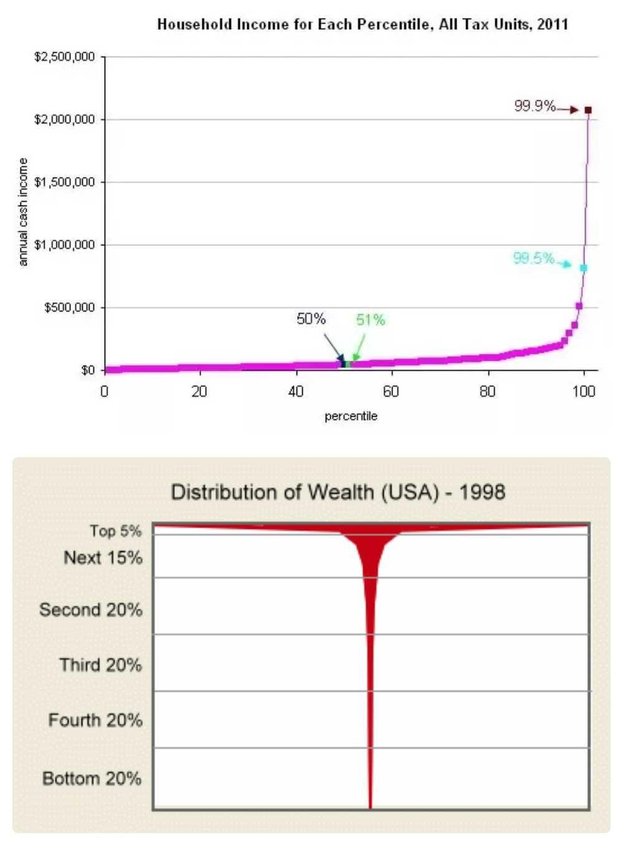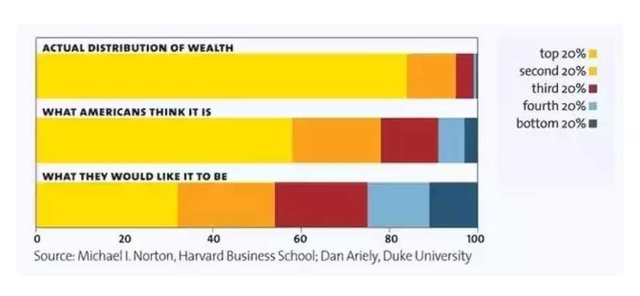The most controvesial political opinion on money distribution
The rich, as a class, contribute far less to society than the poor and working class, while consuming far more of its resources per capita, making them a parasitic social class.
This is a controversial idea in America, because it runs contrary to one of our most enduring social myths. We think of our economy as a meritocracy, where the more you contribute, the more you are rewarded with money. Therefore, we believe, the rich must be those who contribute the most, while the poor are contributing little to nothing. And while the reality is complicated, as a general rule this idea is not only false but in fact the complete opposite of the truth.
First of all, we don’t have an even distribution of income from top to bottom, and yet most people assume we do. What we have instead is a massive amount of wealth concentrated at the very top, and a sharp drop down from there, and then a basically even distribution from what we would call upper-middle class down to the bottom. In other words, most of the people we encounter in life are on an evenly distributed scale. However, there’s also this layer of the incredibly rich, who have orders of magnitude more wealth, and these people are largely invisible unless they choose otherwise. They don’t shop at Wal-mart, ride the bus or eat at Subway. Most of us never interact with people in this class at all, and never will.
And yet, the majority of the wealth earned in this country is earned by them. The majority. They are a tiny class of people, but they represent more of our economy that the tens of millions of people who make up the working class. Here are three different graphs showing this dynamic in different ways:


If you look at that first graph, you can see the median income; that is, the point at which half of the people in our country make more money, and half make less. And relative to the whole graph, those people make essentially the same as those at the bottom. These are the differences that we see in ordinary life: people on state assistance make very little, minimum wage earners also very low, teachers and tradesmen a bit more, doctors and lawyers more than that. That’s the distribution of wealth we tend to see, and it’s what we tend to assume is the whole distribution, more or less. Many people would consider a doctor to be rich, or really, anyone making 6 figures a year. And yet, if you look at every single person making up to $200,000 per year, while you would be looking at most Americans, you would not even be seeing half of the money being made in our economy every year.
So who are this invisible class of people who hold, really, most of the money made in this country? Owners. That’s it; that’s what makes the difference. People who own businesses, either singly or as significant stockholders, are the people to whom the benefits and profits all flow. If you look at every single person who contributes to making a Ford F-150 pickup truck, from the extracting of raw materials in the ground up through selling it at a dealership, every single cog in that chain makes basically the same amount: what the labor market determines is the lowest possible price point for their job. And while it seems like the engineer makes a lot more than the guy sweeping the factory, both of them are at about the same point on the graphs above. ALL of the wealth generated in that process (which means, all of the net gain in value) belongs to the owner of Ford. And what’s significant here is that, by and large, that owner (owners) does not contribute to the creation of the F-150 at all. In the collective endeavor of building a truck, or making a phone call happen, or delivering health care… in all of these economic activities, the people who actually accomplish those tasks are generally compensated in a zero-sum fashion: they take out in dollars what they put in in labor. Meanwhile, the additional value, which is created at every stage in the journey, goes entirely to the designated owner, who almost always contributes nothing. Hence, their role in the system is essentially parasitic: siphoning off wealth (energy) with no reciprocity of value creation. It’s a net burden on the system, and one that has grown extra-ordinarily heavy as of late.
There are caveats and complications, of course, but they are exceptions; this is the rule. And while it’s undeniably true, most Americans ignore the facts because they don’t want to even consider the implications. But regardless of whether it ever gets acknowledged (much less corrected) the ultra-wealthy are the freeloaders of our economy.